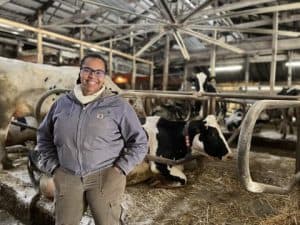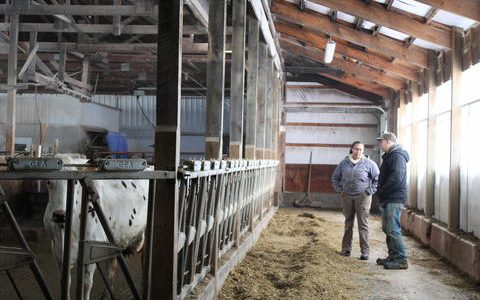MARCH 2022
Dana Adams, University of Minnesota Extension livestock educator, is a dedicated and knowledgeable partner to central Minnesota farmers. She’s also the first African American woman hired as an ag educator at the University of Minnesota Extension. This article turns a spotlight on Dana’s work and accomplishments, and the importance of more equitable and representative agricultural workplaces.
I have a unique platform on which to stand. I can show people of color and other minorities that we deserve a place in this sphere…if you are interested and you are knowledgeable, you have every right to work in this place.
The article is reprinted below with permission from the University of Minnesota Extension.
Dana Adams
University of Minnesota Extension, Livestock Educator
 Extension livestock educator Dana Adams, partnering with farmers across three counties is a career that marries her two professional passions: the animals that produce food and the people whose life work is managing them.
Extension livestock educator Dana Adams, partnering with farmers across three counties is a career that marries her two professional passions: the animals that produce food and the people whose life work is managing them.
Her dedication to farmers is mirrored across Extension. What distinguishes Adams, though, is being the first African American woman hired as an ag educator at University of Minnesota Extension. Like legions who came before her as “the firsts,” Adams finds herself not only an advocate for a just workplace, but for those who follow in her footsteps.
Her place is in Benton, Stearns and Morrison counties; the trio of counties contracts with Extension to share Adams’ position as well educators in crops and horticulture. The path to the fields and barns of central Minnesota started with different intentions for Adams, who was studying human nutrition at the University of Mary Washington in Fredericksburg, Va. During a study abroad program, a visit to a Dutch dairy farm sparked her fascination with the process through which cows convert feed to milk.
“That’s what pulled me in. What kept me in was how people manage that process,” she says. Adams redirected her interests and wound up at South Dakota State University, where she earned a master’s degree in dairy science. Her application included an essay she titled “Cows: Nature’s Natural Recyclers.” She began work at Extension in November, 2020.
An unequal history
For well over a century, the career doors for Black ag professionals and educators remained firmly shut—or opened to jobs with less pay, poorer resources and even threats of violence. As documented in often-cited research by Carmen Harris, history professor at the University of South Carolina Upstate, the nation’s Extension programs were no exception to the rule.
The U.S. Congress created Extension programs at the nation’s land-grant universities with the 1914 Smith-Lever Act. Strong-arm tactics by Southern lawmakers ensured discrimination was hard-wired into it for decades to come. White men were the county agents in the South; Black men were restricted to the lower level of “local agents.” Support for Extension programs at historically Black university and colleges was subject to the whims of state legislatures, leading inevitably to inequitable funding.
Slow changes began in the 1950s, prompted in part when the nation’s Black news media cast much-needed light on the inequities of the Extension system. Pressure intensified during the civil rights movement and passage of laws that rectified at least some of the separate and unequal system that had grown out of Smith-Lever.
Fast-forward to today: The workforce at the University of Minnesota, including E students, according to the most recent statistics gathered xtension, does not reflect the state’s demographics. Creating a representative workplace is one of the key goals of Extension’s diversity and inclusion plan. In agriculture, progress has inched upward, but slowly. Of the master’s degrees earned in ag-related studies, only four percent went to Blackby Purdue University for the USDA.
Breaking new ground
So after a year in a mostly white region, particularly among farm families, how is the job going for Adams?
“In retrospect, there have been a couple times I feel I’ve been treated differently, but quite frankly, I feel I’ve been welcomed with open arms in my work. The fact that I’m African American hasn’t been an issue,” she says.
The hiring committee in the counties she serves recognized they were not only hiring a woman in a once-male-dominated field, but the first non-white educator in the area, says Stearns County Commissioner Steve Notch. Once on board, she’s proven her herself as an educator, one committed to helping livestock farmers, he notes.
“Her enthusiasm during the interview convinced me that she was very capable and would easily receive acceptance from the area farmers once they could see the depth of knowledge she could bring forth and her willingness to find answers to their questions,” Notch says. “As a member of our local Extension Committee, I hope Dana will be around for a long time.”
It’s everyone’s job
Adams credits her parents’ steadfast support of education for helping her reach her educational goals. “For people who don’t have that privilege, it is a significant barrier,” she notes. “There are resources available, but a lot of minority students often don’t know about them.”
For minority students, seeing other people of color in positions like hers helps — so does strengthening diversity, equity and inclusion (DEI) in the workplace. Adams has participated in focus groups looking at race at the University of Minnesota, which identified needs such as a better training for colleagues who identify as allies. Recognizing that DEI is hard work, but yields valuable results, is essential, Adams says.
“We haven’t solved the issues of race, of DEI. I hear people that they’re tired of DEI and I get that they’re tired. I don’t have the luxury of being tired — this is my life,” she says. “It’s important for everyone to see and restate the value of what we do as professionals and representatives of the University of Minnesota.”
See more
